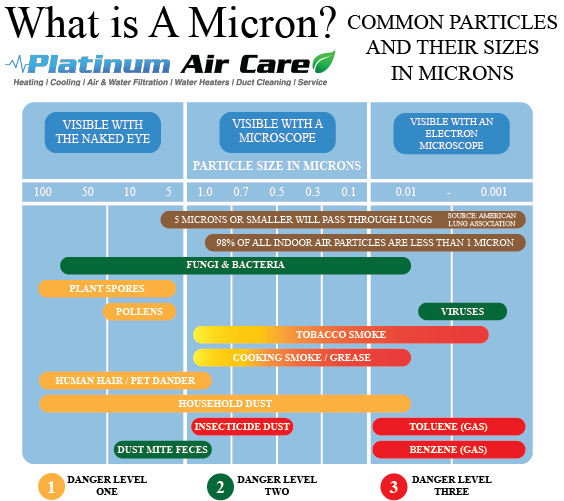What is a Micron or Micrometer?
Estimated Reading Time: 2 minutes
A micron or micrometer is used to analyze very small particles. The symbol for microns is “µm”, and the symbol for micrometer is “µ”. 1µm equals 1.00µ.
One micron is equal to 1/25,400 of an inch or one-millionth of a meter. Particles are commonly measured in microns, a metric unit of length. There are 25,400 microns in one inch. This dot “.“ is approximately 1/64 of an inch wide and is equal to 615 µm.
The chart shown here provides a visual representation of the spectrum of common air contaminants and their measured sizes. Of particular importance when discussing indoor air quality solutions is how effective a product is at capturing/controlling contaminants PM 2.5 (Particulate Matter 2.5) µm or less in size.
The following are some examples of micron sizes:
Oil Smoke - Ranges from 0.03 to 1 µm
Spider web is roughly 1 µm
Animal Dander is approximately 2.5 µm
Spores and Pollen are all larger than 8 µm
Mold Spores range from 10 to 30 µm
The diameter of human hair is 100-20 µm wide (depending on hair thickness)
Most particulate matter below 1.0 µm becomes invisible to the human eye.
Air Quality Health Index & Air Quality Health Data
Real-time air quality monitoring data use the term microns as a unit of measurement for air pollutants.
Any particles less than PM 2.5 µm are classified as a Respirable Suspended Particle (RSP), the health effects and hazards with these small particles are great. RSP’s are particles that are small enough to evade mucosal capture by the protective Alia and mucosa of the human upper respiratory system and invade the deeper reaches of the lungs with serious health consequences.
In fact, any particles of 5 µm or less are considered a definite inhalation hazard because of the inability of the human body to filter effectively these particles from the lungs. Allergenic particles, infectious agents, and toxic gases can cause allergic reactions, headaches, sickness, and many other illnesses or health problems.
Air quality data suggests that since 98% of airborne contaminants are less than one (1) micron in size, knowing the effectiveness of any product at controlling sub-micron particles is very important when making a decision on an air purification system for your home.
Health Risks of Airborne Pollutants — Especially for Sensitive Groups
Breathing polluted air daily can lead to a wide range of respiratory symptoms and long-term health risks — especially for sensitive individuals such as children, seniors, and those with pre-existing conditions. Common issues include shortness of breath, nasal congestion, nosebleeds, headaches, and fatigue.
Long-term exposure has been linked to serious respiratory illnesses like Asthma, Chronic Obstructive Pulmonary Disease (COPD), Sleep Apnea, Cystic Fibrosis, and even Lung Cancer. Managing indoor air quality with high-efficiency air purification systems is one of the best ways to reduce exposure to these dangerous pollutants — especially particles in the micron range.


